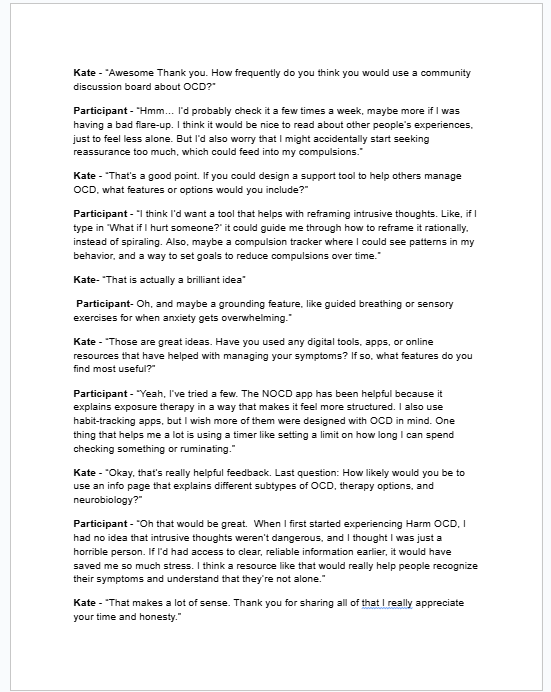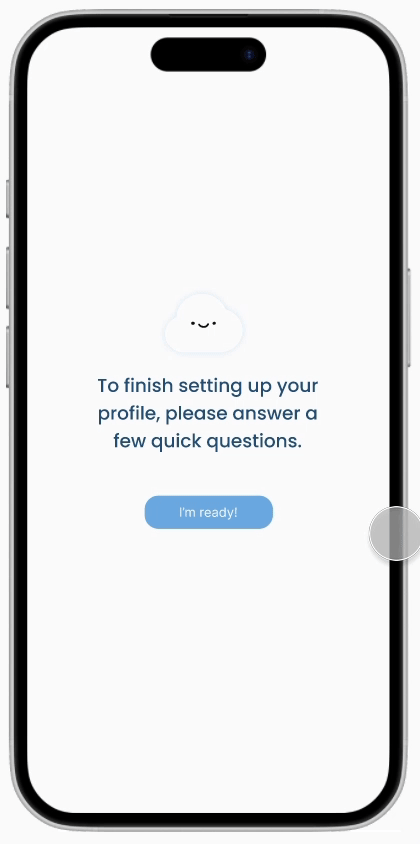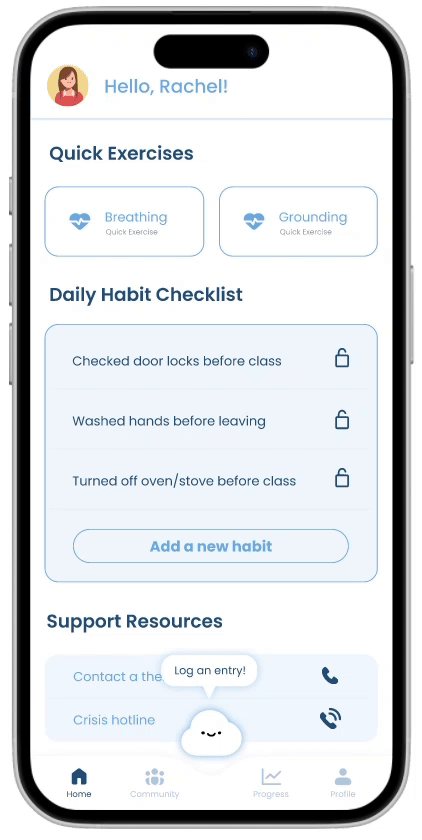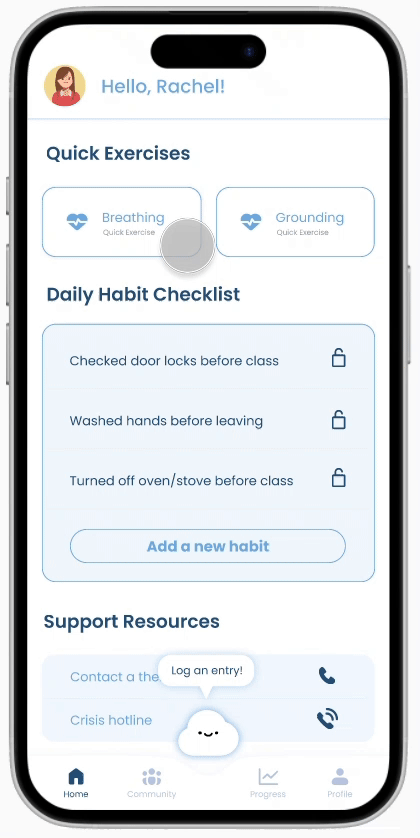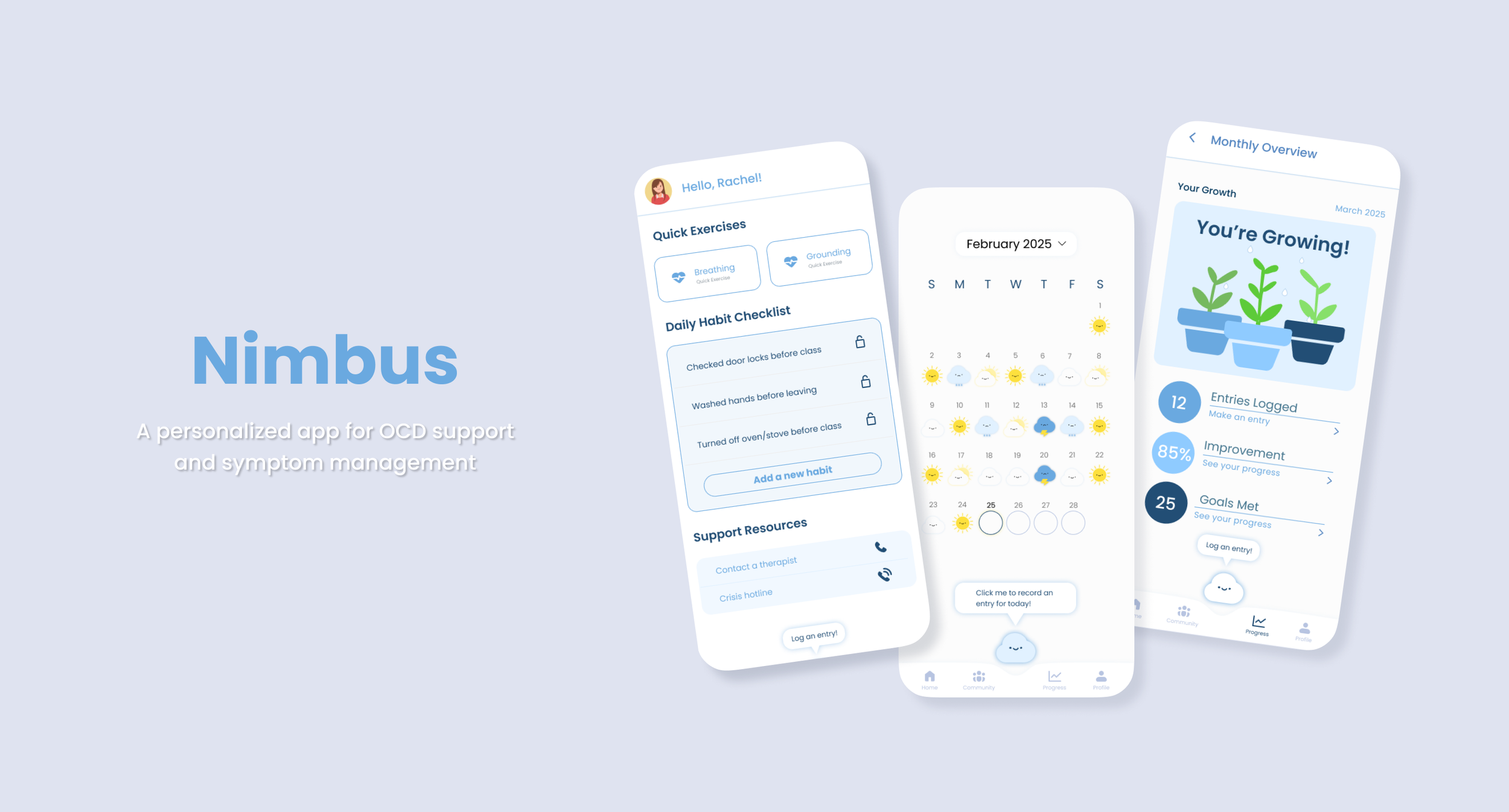
Nimbus is a thoughtfully designed OCD support application, offering an intuitive and user-centered interface that helps individuals and their partners navigate symptoms, track progress, and access valuable resources for effective symptom management and mental well-being.
Nimbus
My Role
UI/UX Designer
Tools Used
Figma
Timeline
Spring 2025
Overview
Project Overview
This project aimed to develop an OCD support application designed to provide individuals with an intuitive and user-friendly platform for symptom management. The primary goal was to create a seamless experience that enables users to track symptoms, access coping strategies, and gain a deeper understanding of their condition through structured guidance and resources. The motivation stemmed from the need for a well-designed, accessible tool that fosters better communication and support, helping users navigate the challenges of OCD with greater ease and confidence.
Problem Statement
Current OCD management apps lack personalization and holistic support.
Initial Thinking
Millions of individuals struggle with OCD symptoms, including intrusive thoughts, compulsions, and anxiety that impact their daily lives. Many find it difficult to access effective resources, support, and therapy. Our goal was to design Nimbus, a user-centered mobile application that provides structured symptom management, community engagement, and professional support to help individuals navigate their OCD more effectively.
Individuals experiencing OCD symptoms seeking structured support
Partners and loved ones of those with OCD who want to better understand and provide support
Young adults and students managing OCD while balancing school, work, and relationships
Target Users
How might we create an intuitive and stigma-free platform for OCD management?
How might we help users track symptoms and recognize patterns in their experiences?
How might we provide community-driven support while maintaining privacy and security?
How might we integrate professional resources for those seeking therapy or guidance?
How Might We Questions
Competitive analysis of existing mental health and OCD management apps
Interviews with individuals diagnosed with OCD to understand their needs and pain points
Surveys conducted within online OCD communities to gauge user expectations
Online Ethnography of existing OCD communities
Research Methods
Research 1 - Existing Tools
NOCD
Clarity
OCD.app
Current Apps Available:
Key Insights
Many OCD-focused apps lack holistic, integrated support
Community support is rarely emphasized or well moderated
Coping tools often reinforce checking behaviors instead of reducing them
User Research
Background Research
Understand the most common OCD symptoms and challenges users face
Identify gaps in existing OCD support applications
Determine user preferences for tracking, community, and professional support features
Research Goals
Intuitive Symptom Tracking: Log intrusive thoughts and compulsions without reinforcing behaviors.
Personalized Coping Tools: Tailored ERP, CBT, and ACT-based strategies.
Private & Community Support: Choose between private journaling or anonymous discussions.
Minimal & Accessible UI: Customizable themes, fonts, and a distraction-free interface.
Target Needs and Goals
We conducted a qualitative analysis of over 80 community posts on Reddit and online forums. Themes emerged around stigma, symptom expression, coping methods, and emotional impact.
Online Ethnography
Community Support is Lacking: Many users feel isolated, misunderstood by friends/partners, or fear judgment.
Intrusive Thoughts Are Taboo: Users hesitate to share Harm OCD thoughts due to fear of misinterpretation.
Coping Methods Vary Widely: Users self-soothe with timers, photos, journaling, mental mantras, or avoidance.
Emotional Toll is High: Frustration, shame, and confusion were common. Many describe daily disruptions due to checking, contamination fears, and compulsive rituals.
Differentiating Symptoms is Difficult: Users struggle to separate compulsions from coping tools, leading to unintentional reinforcement.
Key Insights
Top Keywords & Themes:
Intrusive thoughts, compulsions, confusion, stigma, support, trauma, shame, checking, contamination, reassurance, neurobiology, therapy limitations, co-occurring disorders.
User Responses
Interviews & Surveys
We conducted 4 one-on-one interviews to identify specific user needs.
High Interest in Habit Tracking Tools: Lockbox/checklist feature was rated 4.8/5 in usefulness for reassurance tracking.
Anonymous Community Boards Are Preferred: Users want to connect, but need privacy due to stigma or shame.
Desire for Reframing & Grounding Tools: Users asked for ways to manage thoughts without reinforcing compulsions.
Educational Content Is Empowering: Many wished they had access to subtype and therapy info earlier in their diagnosis.
Gamification & Visual Confirmation Help: Photo-based check-ins, streaks, and calming animations are encouraging.
Key Findings
Prototyping
Visual Identity:
Nimbus icon = friendly cloud
Soft, muted palette with customizable themes
Weather related icons for mood tracking
Navigation:
Bottom nav bar for quick access
Interactive cloud icon on homepage
Personality quiz at sign-up to tailor features
Design Decisions
Wireframes
We began with wireframes to map out core features like mood tracking, the lockbox, community posts, and breathing exercises. These early layouts helped us test navigation flow, identify pain points, and iterate quickly based on user feedback. The wireframes focused on clarity to reduce cognitive overload for users managing OCD symptoms.
User Feedback
We ran a usability test on Maze with 5 participants and measured performance across key tasks. Overall, test users found Nimbus intuitive and visually calming, with several features standing out as helpful for managing OCD-related challenges. However, we also identified some major designs that needed refinement.
Usability Testing
100%
users successfully completed all tasks
48%
misclick rate on the Mood Tracker
32%
misclick rate on reading an article
"The guided exercises are so convenient and easy to use"
"This app gives an outlet to individuals with OCD to write down their habits and feeling"
"I think it would help my overthinker brain using it"
““The cloud button confused me at first, but once I understood it, I really liked how quick it was to track my mood”
Key Feedback
High-fidelity Design
Based on our usability testing, we refined our final prototype to better cater towards the user’s needs as well as make the overall UI more intuitive.
Design Solution
Personalization Quiz
01
Personalization Quiz during app signup to help tailor the app to each user’s specific needs and wants. Users’ answers to the questions on the quiz will allow the app to determine what goals they want to achieve and what steps they need to take to get to that point.
02
Helps users manage compulsions by recording proof of completed actions (e.g., photo of locked door or typing in their coping strategy), reducing their urge to re-check throughout the day.
Lockbox & Checklist
03
Clickable cloud on bottom navigation bar allows users to quickly track daily mood and progress. Different designs reinforce streaks and growth, and users can see their weekly progress.
Mood Cloud
04
Anonymous, customizable usernames make users feel safe and connected. Includes options to upvote, comment, and bookmark posts or informational articles.
Community Board
05
Breathing exercises, grounding activities, and reframing prompts available for immediate support. These help users to reconnect to themselves when in moments of anxiety or stress.
Guided Tools
Impact
Nimbus provides a nonjudgmental space for young adults with OCD to track symptoms, access evidence-based tools, and connect with a supportive community
Reflection
This project taught me how deeply design choices affect mental health tools. From anonymity in social features to intuitive trackers, every detail matters when building for vulnerable users.
If given more time, I’d explore integration with professional therapy platforms and expand our features for partners and loved ones.
Working on Nimbus reminded me that empathy is not just a design principle, it’s the foundation of everything we build!






